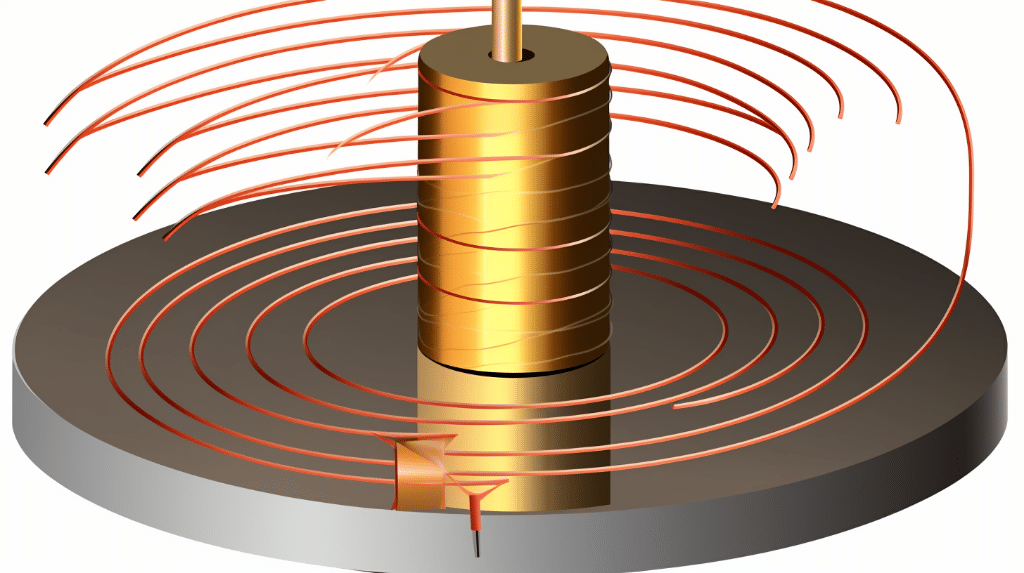Electromagnets play a crucial role in various fields, from industry and transportation to everyday devices like doorbells and speakers. Their strength is determined by factors like the current flow, the number of coils, and the presence of an iron core. In this blog post, we will explore different ways to increase the strength of an electromagnet, discussing the underlying principles and providing practical examples. So let’s dive in!
Ways to Increase the Strength of an Electromagnet
Increasing the Current Flow
To understand how increasing the current enhances electromagnet strength, let’s take a closer look at the relationship between electric current and the magnetic field it generates. According to Ampere’s Law, a magnetic field is produced when an electric current flows through a conductor. The strength of this magnetic field is directly proportional to the current. In other words, the greater the current flowing through the wire, the stronger the magnetic field produced by the electromagnet.
Practical Ways to Increase Current Flow
There are several practical ways to increase the current flow in an electromagnet. One way is to increase the voltage applied to the circuit. According to Ohm’s Law (V = IR), an increase in voltage (V) will result in a corresponding increase in current (I), given that the resistance (R) remains constant.
Another method is to lower the resistance of the wire. This can be achieved by using wires with a larger cross-sectional area, as larger wires have lower resistance. Additionally, minimizing the length of the wire reduces resistance, as shorter wires have less resistance.
Adding More Coils
The number of coils in an electromagnet also plays a crucial role in determining its strength. More coils result in a stronger magnetic field. This is due to the cumulative effect of each individual coil, which contributes to the overall magnetic field strength.
The Role of Coils in Electromagnet Strength
Each coil in an electromagnet acts as a separate magnet, generating its own magnetic field. When multiple coils are wound together, their individual magnetic fields align and reinforce each other, resulting in a stronger combined magnetic field. This phenomenon is known as magnetization.
How to Add More Coils to an Electromagnet
Adding more coils to an electromagnet is relatively simple. One approach is to wind additional turns of wire around the core. This increases the number of coils and, consequently, enhances the strength of the electromagnet. However, it’s important to ensure that the additional coils are evenly distributed and tightly wound to maximize their effectiveness.
Using an Iron Core

The presence of an iron core in an electromagnet significantly increases its strength. Iron is a ferromagnetic material, meaning it easily magnetizes and demagnetizes in the presence of a magnetic field. When an iron core is inserted into the coil of an electromagnet, it enhances the magnetic field strength.
Why an Iron Core Increases Electromagnet Strength
The iron core serves to concentrate and direct the magnetic field. When a current flows through the wire coils, the iron core becomes magnetized, strengthening the magnetic field produced by the electromagnet. This increased magnetic field results in a more powerful electromagnet.
How to Incorporate an Iron Core in an Electromagnet
To incorporate an iron core into an electromagnet, simply insert a piece of iron or a ferromagnetic material into the center of the coil. The core should be made of a material that is easily magnetized, such as soft iron. This will maximize the concentration of the magnetic field and boost the overall strength of the electromagnet.
What Not to Do: Actions that Do Not Increase Electromagnet Strength
Common Misconceptions about Electromagnet Strength
There are a few common misconceptions about increasing electromagnet strength. One misconception is that increasing the voltage alone will enhance the magnetic field. While voltage is a factor in increasing current, without considering other factors such as resistance and coil design, increasing voltage alone may not lead to a significant increase in electromagnet strength.
Ineffective Methods for Increasing Electromagnet Strength
Certain methods for increasing electromagnet strength are ineffective or might even have adverse effects. For example, adding more batteries in series without considering the wire’s capacity may result in overheating, damage to the wire, or even short circuits. Similarly, increasing the number of turns in the coil without considering the wire’s thickness or resistance can also lead to inefficiencies.
Practical Applications: Using Enhanced Electromagnets
Examples of Enhanced Electromagnets in Everyday Life

Enhanced electromagnets find applications in various fields. One common example is the loudspeaker, where an electromagnet is used to drive the movement of a diaphragm, producing sound waves. By increasing the strength of the electromagnet, the speaker can produce louder and clearer sound.
Another example is magnetic lifting systems used in industrial settings. These systems use powerful electromagnets to lift heavy objects like scrap metals or magnetic materials. By increasing the strength of the electromagnet, these systems can handle larger loads and improve efficiency.
Potential Future Applications of Stronger Electromagnets

As technology continues to advance, the need for stronger electromagnets becomes paramount. Stronger electromagnets can contribute to the development of more efficient electric motors, magnetic levitation systems, and even advanced medical equipment like magnetic resonance imaging (MRI) machines. With increased strength, these electromagnets can provide better performance, higher precision, and improved functionality.
By understanding and implementing the various methods to increase the strength of electromagnets, we can unlock their full potential and pave the way for countless technological advancements.
Don’t hesitate to experiment and explore these concepts further. Remember, the strength of an electromagnet lies in your hands!
How do examples of increasing the strength of an electromagnet relate to examples of muscular force in action?
The intersection of increasing the strength of an electromagnet and examples of muscular force in action can be seen in the concept of electromyography. Electromyography is a technique used to measure and record the electrical activity of muscles. By using electromagnets to generate a magnetic field and measuring the resulting muscle contractions, researchers can gain insights into the force exerted by muscles. Examples of muscular force in action can be found in various activities such as lifting weights, throwing a ball, or even walking. To explore further examples of muscular force in action, you can visit Examples of muscular force in action.
Numerical Problems on how to increase the strength of an electromagnet
Problem 1:
An electromagnet has 200 turns in its coil and carries a current of 4 A. The magnetic field strength inside the coil is 0.02 T. Determine the magnetic field strength if the number of turns is doubled and the current is tripled.
Solution:
Given:
Number of turns, ![]()
Current, ![]()
Magnetic field strength, ![]()
We need to find:
New magnetic field strength, ![]()
The magnetic field strength inside a coil is given by the formula:
![]()
where:![]() is the permeability of free space (constant),
is the permeability of free space (constant),![]() is the number of turns,
is the number of turns,![]() is the current, and
is the current, and![]() is the length of the coil.
is the length of the coil.
We can rearrange the formula to solve for the new magnetic field strength ![]() :
:
![]()
where:![]() is the new number of turns, and
is the new number of turns, and![]() is the new current.
is the new current.
Now, let’s substitute the given values into the formula:
![]()
![]()
![]()
Simplifying further, we can calculate the value of ![]() .
.
Problem 2:
An electromagnet has a magnetic field strength of 0.05 T and carries a current of 6 A. If the number of turns in the coil is reduced to half and the current is tripled, determine the new magnetic field strength.
Solution:
Given:
Magnetic field strength, ![]()
Current, ![]()
We need to find:
New magnetic field strength, ![]()
Using the same formula as in Problem 1, we can rearrange it to solve for ![]() :
:
![]()
Substituting the given values:
![]()
![]()
Simplifying further, we can calculate the value of ![]() .
.
Problem 3:
An electromagnet is constructed with a coil that has a magnetic field strength of 0.03 T and carries a current of 5 A. If the length of the coil is doubled and the number of turns is tripled, find the new magnetic field strength.
Solution:
Given:
Magnetic field strength, ![]()
Current, ![]()
We need to find:
New magnetic field strength, ![]()
Using the same formula as before:
![]()
Substituting the given values:
![]()
![]()
Simplifying further, we can calculate the value of ![]() .
.
These three numerical problems illustrate how to increase the strength of an electromagnet by varying different factors such as the number of turns, current, and length of the coil.
Also Read:
- Conduction
- Polarization types
- Is conductivity a physical property
- Electromagnetism
- A rich introduction to electromagnetism
- Dynamic equilibrium example
- Anatomy of the human ear
- How physical changes can be reversed
- Where is friction not useful
- Good conductors examples

The lambdageeksScience Core SME Team is a group of experienced subject matter experts from diverse scientific and technical fields including Physics, Chemistry, Technology,Electronics & Electrical Engineering, Automotive, Mechanical Engineering. Our team collaborates to create high-quality, well-researched articles on a wide range of science and technology topics for the lambdageeks.com website.
All Our Senior SME are having more than 7 Years of experience in the respective fields . They are either Working Industry Professionals or assocaited With different Universities. Refer Our Authors Page to get to know About our Core SMEs.